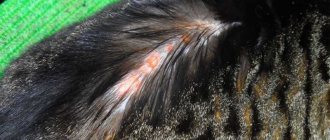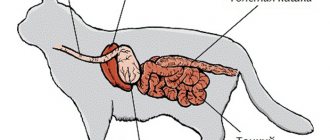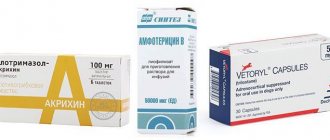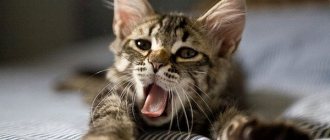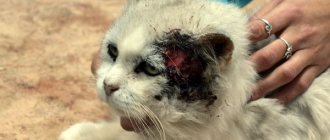In cats, spotting can be either normal or a sign of serious illness. In the first case, they accompany normal physiological processes, such as estrus or cleansing of the uterine cavity after childbirth. But if the discharge appears at the wrong time, causes discomfort to your pet and has a foul odor, you should consult a veterinarian as soon as possible. If this is not done, the animal may die.
So, how to distinguish normal discharge from pathological ones and how to treat a cat?
Risks of the condition
Regular or large amounts of blood loss can weaken even the strongest organism, which cannot cope with bleeding on its own without outside intervention. Severe blood loss in a cat can result in the following:
A single bleed in a cat is not dangerous.
- disruption of mechanical circulatory function;
- insufficient filling of blood vessels and cardiac compartments with blood;
- falling blood pressure;
- a sharp decrease in red blood cells and a drop in hemoglobin levels leads to the development of anemia;
- tissue hypoxia (oxygen starvation) due to a disrupted process of oxygen transfer through vessels to tissues and organs;
- disruption of local metabolic processes, which leads to massive cell death, and then the death of the organism.
General anesthesia
A more well-known term is anesthesia. It involves putting the animal into deep medicated sleep, accompanied by a complete shutdown of all pain. To reduce the dose of the “sleeping” drug and facilitate further recovery from anesthesia for the cat, any general anesthesia is preceded by premedication. This is the name given to the administration of mild sedatives and muscle relaxants. Without premedication, induction into anesthesia is much more difficult, and the risk of developing many complications increases significantly.
Any anesthesia can be performed either using one (less often two) drugs, or using a combination of several drugs. In the first case we are talking about mononarcosis, in the second – about polynarcosis (mono- and polyvalent types, respectively).
Simple, one-component anesthesia, despite the ease of implementation and the relative ease of calculating the dose, is an option suitable only for light, short operations. Despite all the successes pharmacists have achieved in recent years, ideal and “multifunctional” drugs for anesthesia still do not exist.
In particular, there are no means (especially in veterinary medicine) that would allow long-term operations. If complex surgical intervention is necessary, in any case it is necessary to use a combination of several drugs that enhance or smooth out the effect of each other.
Inhalation anesthesia
It is also known as “gas anesthesia”. It is believed that inhalational anesthesia is the most preferred method. There are several reasons for this:
- Medicinal substances, when delivered to the lungs in the form of a fine aerosol, are absorbed by the body much faster and better. This allows you to quickly put the cat under anesthesia and significantly reduce the volume of medications required for anesthesia.
- By reducing the dose, it is possible to bring the operated animals out of anesthesia noticeably faster, and the cat recovers from its consequences much easier.
- Only inhalation anesthesia allows unhindered access to many organs of the respiratory system, oral and nasal cavities.
However, in the latter case, not everything is so smooth. It is not always possible to supply a gaseous mixture through a mask, and therefore one has to resort to the same tracheal intubation. Because of this, the possibility of operating on many organs of the respiratory system is significantly reduced.
Important! In addition, inhalation anesthesia (due to its pronounced vasodilating effect) is characterized by a serious drop in blood pressure. To avoid death (or development of neurological disorders) of the cat from arterial collapse, blood pressure must be monitored throughout the operation.
Parenteral anesthesia
The most common type of anesthesia is when drugs are administered intravenously into the animal's body.
This technique also has a number of significant advantages:
- Possibility of perfect control of drug dosage. Simply put, the veterinarian knows exactly what volume of medicine and at what speed was infused into the cat’s circulatory system.
- The possibility of a smooth and gradual withdrawal of the animal from anesthesia, both due to a gradual decrease in the volume of the active substance, and through the introduction of “antidotes” that stop the effect of the drugs.
- Simplicity of the technique. It is not always technically possible to administer inhalation anesthesia, while any veterinarian can perform intravenous infusion, even at home.
Of course, parenteral anesthesia also has its disadvantages:
- Firstly, part of the drug in this case inevitably passes through the liver, which processes it. This leads to two negative aspects. First of all, some metabolites can be very harmful to the animal’s body (which manifests itself, among other things, in the form of severe recovery from anesthesia). In addition, in some cases the medicine may act too weakly, or its effect will suddenly end right in the middle of the operation. All this is fraught with the death of the animal from painful shock.
- Secondly, most of the drugs used for such anesthesia help to reduce the frequency of respiratory movements and a sharp deterioration in pulmonary ventilation. To prevent the cat being operated on from dying from suffocation, its trachea is intubated. Simply put, a special plastic tube is inserted into it, through which air flows directly into the animal’s lungs. Because of this, intravenous anesthesia is often impossible to use for operations on the respiratory, oral or nasal cavities.
Important! In veterinary practice, “pure” inhalation or intravenous types of anesthesia are used only in cases of relatively simple and quick operations.
If complex abdominal surgery is required (for sterilization with the need to remove the uterus and ovaries, for example), combined types of anesthesia are used. Thus, a specialist can carry out primary anesthesia by administering the necessary drugs intravenously, after which the cat is kept in the desired state by administering maintenance doses of drugs in the form of an aerosol (through tracheal intubation).
Withdrawal from general anesthesia
It is carried out by gradually reducing and further stopping the supply of anesthetic substance. In some cases, drugs that support cardiac and respiratory activity, as well as drugs that block the action of anesthetics, are additionally administered.
Overt and hidden internal bleeding
Discharge from a pregnant cat: bloody, yellow
It is impossible to see internal bleeding in a cat. But some similar processes are manifested by certain external symptoms and are called overt internal bleeding.
Table of external symptoms of obvious internal bleeding:
| Type of obvious internal bleeding | Accompanying external symptoms |
| Esophageal | Vomiting with bright scarlet blood. |
| Gastric | Burgundy or brown clots of coagulated blood in the vomit. |
| Intestinal | Burgundy or brown clots of coagulated blood in vomit (small intestine) and/or stool with traces of dark blood or black in consistency like coffee grounds (lower intestines). |
| Pulmonary | Wet cough with bloody foam. |
| Royal | Bloody discharge from the loop. |
| Renal | Blood or traces of it in every urine sample. |
External symptom of obvious internal bleeding
Anesthesia for a cat
Cat after anesthesia - what to do in the first few hours? What drug for anesthesia is considered the best? What complications may arise? These questions are asked by every cat owner who has been recommended by a veterinarian to undergo a procedure or surgery under general anesthesia. However, today anesthesiology is developing very quickly, “heavy” drugs have not been used in work for a long time, and anesthesia for cats is becoming safe and comfortable.
We at the veterinary level are confident that there is no need to be afraid, because modern drugs, equipment and specialists are able to make the process of putting a cat in and out of general anesthesia as gentle and comfortable as possible for the patient.
Equipment for monitoring the level of depth of anesthesia practically automates the preparation of the patient for a diagnostic procedure or surgical intervention. The fact that veterinary anesthesiologists were the first in Russia to use the BIS monitor in veterinary medicine confirms the high level of qualifications of our specialists.
Based solely on digital indicators of the animal’s basic vital processes, our anesthesiologists keep the cat under anesthesia for exactly as long as the procedure requires, without allowing it to wake up ahead of time.
In addition, our specialists also have a latest generation humidifier of gas mixtures in their arsenal to maintain the required body temperature during anesthesia, because cooling the patient during anesthesia even 1 degree below normal means a decrease in the animal’s metabolism by 10%.
As for the types of anesthesia, in our work we mainly use gas anesthesia for cats, the consequences of which are minimal for the animal - it does not have a negative effect on the liver.
Causes of bleeding in cats
A cat has a nosebleed: causes and diagnosis
There are many reasons explaining this condition.
Pyometra
In cats, bleeding from the vagina is a frequent companion to a disease such as pyometra. The development of this disease is most often provoked by an excess amount of progesterone in the cat’s body, which is produced in the following cases:
- uncontrolled use of hormonal contraceptives to prevent pregnancy;
- poor hygiene during estrus;
- violation of sanitary standards during childbirth;
- uncontrolled matings;
- impaired immunity, congenital hormonal changes;
- lack of physical activity.
Those at risk most often are elderly, nulliparous, pregnant cats with pathologies, including those who gave birth prematurely.
A cat with pyometra suffers a lot of pain
Endometritis
Endometritis is an inflammation of the walls of the uterus, often accompanied by a purulent process that further damages the organ, which provokes uterine bleeding. The greatest danger is the development of the disease in the postpartum period, when the uterine tissue has not yet recovered, and the slightest damage leads to copious bloody discharge from the cat’s uterus.
Note! It is recommended to sterilize the young female to prevent the development of endometritis and pyometra.
Bleeding disorder
Bleeding disorders in cats can be present from birth or develop later in life. Defects in the protein responsible for coagulation provoke prolonged blood flow and the formation of hematomas in the deep layers of tissue. Platelet defects result in frequent superficial bruising, nosebleeds, black, pasty stools when the intestines are damaged, and difficulty stopping blood after injections or surgery.
One of the symptoms of a bleeding disorder is that the blood does not stop well when the ear is damaged.
Congenital bleeding disorders include hemophilia type A, B, von Willebrand disease, Chediak-Higashi syndrome, Ehlers-Danloos syndrome, known as cutaneous asthenia.
For your information! The clotting process can be disrupted by pet poisoning with rat poison, weakened immunity and infectious diseases such as viral leukemia, infectious peritonitis, feline distemper or toxoplasmosis, as well as chronic diseases of internal organs.
Vaginitis
Vaginitis is an inflammation of the vaginal mucosa.
Many owners mistake vaginitis for estrus due to the fact that cats suffering from this disease are attracted to males. The cause of the disease is most often an unsuccessful mating.
Symptoms of the disease:
- bleeding from the vagina;
- frequent urination;
- swelling of the vulva.
If you suspect vaginitis, it is recommended to wash your cat's vagina with a chamomile solution.
If this bleeding does not stop, you should contact a specialist as soon as possible.
Symptoms of bleeding from the uterus in a cat
The cat has bleeding on the second day after giving birth
Due to uterine bleeding, the cat becomes lethargic and apathetic, she has a refusal to eat, pale visible mucous membranes (tongue, gums, ear, nose) and sensitive hypothermia of the paws. Such symptoms indicate insufficient blood supply to body tissues.
Note! During intrauterine bleeding, blood in a cat rarely leaks onto the external genitalia, as it accumulates in the uterine cavity.
According to statistics, about 70% of bleeding develops according to a moderate principle, that is, the accompanying symptoms appear and increase over several days or weeks. The pet gradually becomes more and more phlegmatic, lethargic, begins to sleep more and more, loses appetite and loses weight, and the stomach, on the contrary, swells like a balloon due to the blood accumulating inside the uterus.
The main symptom of cat uterine bleeding is lethargy.
Why might it start?
There can be a lot of predisposing factors; their groups are often combined, and therefore we will consider only the most common ones. So, one of the most common causes is injury.
Cats in the spring are very serious about procreation, which is why they often fall out of windows, get hit by cars, and otherwise receive serious damage to internal organs . It is not surprising that the uterus may be among the latter.
Note that the walls of this organ contain a mass of large blood vessels, which is why any injury to it is potentially very dangerous and threatens rapid death from massive blood loss. The animal becomes especially vulnerable during pregnancy, as well as immediately after birth. At this time, the walls of the uterus and its mucous membrane swell and thicken greatly, the organ itself becomes tens of times larger, and therefore the likelihood of injury seriously increases.
Various endometritis and cases of pyometra are very dangerous. In these diseases, pus and other “production waste” severely damage the wall of the organ, which, as we remember, contains many blood vessels. It is for this reason that all postpartum inflammatory diseases must be treated immediately, without delaying the process.
What to do if your cat is bleeding
A pet with bleeding requires an urgent professional examination, which will establish the correct diagnosis and prescribe the necessary treatment. Attempts to stop prolonged or heavy blood loss using folk remedies can lead to the death of the cat. This is especially true in cases of bleeding in a kitten, since there is little blood in its body, and the loss of even the smallest dose can provoke the death of the baby.
Did your cat fall out of a window, get hit by a car, or become a victim of a beating? It is highly recommended that you visit a veterinarian, even if there are no visible injuries and your pet appears normal. Internal bleeding that does not open immediately after an injury can appear at any time due to a burst hematoma or a purulent process. It is recommended to carefully move the injured animal into a box with a hard bottom in order to eliminate complications from a possible spinal fracture.
Professional veterinary care
A cold compress is applied to the suspected bleeding site. If possible, the mouth and airways are carefully cleared of blood or vomit. It is strictly forbidden to feed or water an injured cat. If your pet loses consciousness, it is not recommended to stir, trying to bring him back to his senses, as such actions can aggravate the condition.
Note! If a cat is bleeding profusely from the uterus, you can give it water or warm broth and urgently visit a veterinarian or call him at home.
Diagnosis and treatment
The appearance of bloody discharge under the tail, not associated with a physiological condition - estrus, requires contacting a qualified doctor for the necessary help. There are a large number of reasons for the appearance of blood in the tail area, and it is important to accurately determine the main one, which led to secondary symptoms.
Before going to the veterinary hospital, the pet owner can apply cold to the abdominal area and also give the pet complete rest. Cold helps relieve pain, narrow the lumen of blood vessels and stop bleeding for a short period.
Diagnosis of the pathological condition comes down to the following points:
- taking a general blood test from a vein;
- conducting a biochemical blood test to determine dysfunction of internal organs;
- analysis of urine and feces;
- ultrasonography;
- radiography.
The main task of the doctor is to stop the bleeding, find out the cause of the development and prescribe appropriate treatment for the underlying pathology. In case of uterine bleeding caused by injury or inflammation, surgical intervention is more often performed, the purpose of which is resection of the uterus (hysterotomy).
Doctors recommend sterilization with complete removal of the reproductive organs of animals that have reached sexual maturity and have no breeding value. Hysterotomy for bleeding from the uterus is also used for physiological abortion. This is due to the fact that applying ligatures to large blood vessels is always associated with risks. It is easier to remove the reproductive organ and appendages, thereby preventing the development of complications.
Diagnosed urolithiasis implies the use of special medications - antispasmodics and painkillers. Large stones formed in the genitourinary system require surgical intervention. After surgery and stone removal, it is important to follow a special diet.
Malignant neoplasms in the rectum or other parts of the large intestine are treated surgically, and are also supplemented by taking chemotherapy drugs that inhibit the growth of a malignant tumor.
The kitten's tail is wet
Having bought a small kitten, the owner often worries about its health. Any problems cause concern and a desire to help the baby. This is quite natural and commendable, as is a timely visit to the veterinarian.
Kittens are very playful. They happily run after everything that moves in front of their nose. Having noticed his tail, the baby can chase it. However, excessive attention to the tail may indicate the presence of worms or a lack of vitamins.
If the absence of hair and tail is unusual for the kitten’s breed, it means that it has a congenital pathology. It can occur due to abnormalities in intrauterine development. If a cat was given drugs during pregnancy that are teratogenic, such as griseofulvin, the kittens may be born not only without fur and a tail, but also deaf and blind, or die in the womb.
When a kitten has wetness under its tail, only a veterinarian can make a correct diagnosis when examining the animal. If the anal glands are inflamed, there may be an unpleasant odor, the kitten will constantly rub its butt and ride on it.
We invite you to familiarize yourself with: Selkirk Rex cats with curls
There may be some kind of viral disease - enteritis or coronavirus. To prevent the animal from dying, it needs professional medical care.
Young kittens may have kidney problems or cystitis immediately after birth. It's often wet under the tail. If the kitten does not get help, dehydration will occur, it will weaken and will not be able to suckle from its mother. Such kittens quickly lose weight.
To prevent dehydration, kittens are given warm saline solution often and little by little. At the first stage, a saline solution with catazal is injected. They also give cantarene with liarsine or “Healthy Kidneys”. The veterinarian called to the house must write out a detailed treatment plan.
When problems begin during childbirth in a cat, it is better to call a veterinarian at home. When this is not possible, and time is running out, you can try to very carefully help the animal.
When a kitten walks paws forward, its head may get stuck. The vulva is very carefully smeared with Vaseline, the kitten is wrapped in gauze or cotton cloth, and during the next contractions the cat is carefully pulled out using screw-like movements. Someone has to keep the cat.
A kitten's tail consists of vertebrae. Their number can range from 19 to 23. A long tail is a sign of good health of the cat. Typically, adult animals have a tail length of no more than 28 centimeters.
If a kitten was born with a long tail, this is his personal characteristic. The tail serves not only as decoration, but also helps cats express their emotions and communicate with each other. The long tail is a wonderful counterbalance that helps the kitten not to fall while playing or climbing at heights.
Useful materials:
- The cat has cancer Stages of mammary gland cancer in cats Like in humans, cat mammary cancer has ...
- Cat's eye Causes and signs of various types of eye diseases in cats Cats have many eye diseases. Necessary…
- Cutaneous horn General description of the disease Cutaneous horn on the forehead or face (ICD 10 code - L57.0) -...
- Bald patches on a cat For many people, pets, be they cats or dogs, for example, have become not just animals,…
Clinical picture
This disease is characterized by a relapsing course with exacerbations that occur more often in the warm season (more microorganisms). The main signs are: severe itching, which is why a sick cat can scratch the skin vigorously, sometimes until it bleeds; rashes on the affected skin, peeling, flaking; dry skin all over the body.
Blisters and papules gradually form on the skin. They open, resulting in a large amount of ichor flowing onto the skin. Being contaminated with pathogenic and conditionally pathogenic microflora, the exudate begins to decompose and smell bad. All this not only causes your pet severe pain, but can also cause the development of septic phenomena.
The rashes vary depending on the age of the sick animal and its initial physiological state:
- At the first stage, they have the appearance of bubbles, which merge, forming crusts and drying foci of inflammation, and from the latter, however, ichor constantly oozes.
- During the second stage, peeling and wetting intensify even more, the lesions have clear boundaries, and show (as in the previous case) a tendency to merge.
- At the third stage, foci of weeping inflammation can cover the entire body. Cases are rare, since with such a degree of neglect of the pathology, animals, as a rule, die from sepsis and/or general intoxication of the body, secondary infections, pain shock, etc.
We suggest you read: Treatment of scabies in cats (demodex)
During the period between exacerbations, white dry skin may peel off, and new blisters may occasionally form. It should be noted that in the case of cats, it can be difficult to draw the line between the different stages of the disease. This is due to the fact that the animal constantly rubs and scratches the inflammation, as a result of which the pathological process tends to constantly worsen.
